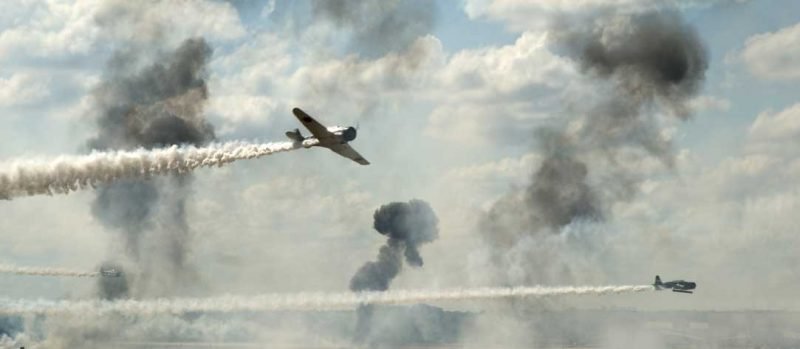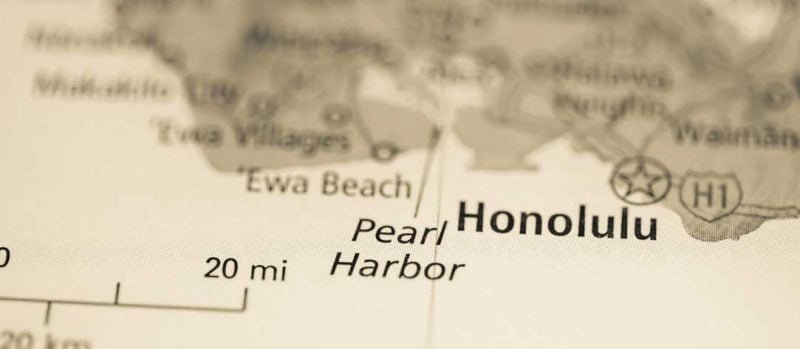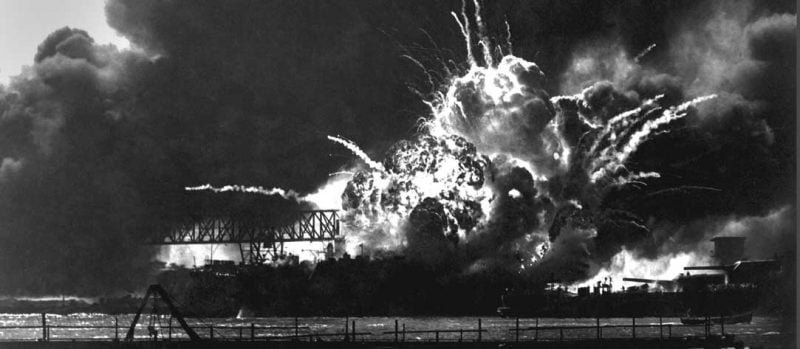Pearl Harbor, Oahu – The Attack: Facts and Information

Why Was Pearl Harbor Attacked?
The Japanese dreamed of an Empire in Asia and began their quest in early 1931. They overran Manchuria and established it as a state, which they named Manchukuo. Moving into China, the Japanese were initially successful, but ultimately encountered the resistance of the Chinese, under the government Chiang Kai-shek. A crisis arose in 1937 when Japan launched a major offensive in an effort to reduce China into submission.
When this tactic was unsuccessful, Japan adopted a policy of economic strangulation. By 1939, major coastal ports were seized and the Chinese capital was forced to move from Nanking to the inland area of Hankow.
In 1940, the French allowed the entry of Japanese troops into Indochina. A treaty was made with Thailand (Siam). By the end of 1940, the Japanese were threatening Burma Road, China’s last supply line from the outside world. By July 194l, they had completed their occupation of French Indochina and turned their sights to Thailand, Burma, and the Philippines.
Concerned over Japan’s ambitions, the US, Netherlands and Great Britain froze Japanese assets in their countries and imposed stringent economic restrictions, cutting off 90% of raw materials required by Japan for war production. The US demanded that aggressive actions against China and Indonesia be halted. Japan was forced to choose between abandoning her efforts or seizure of other areas rich in raw materials. Abandonment was unthinkable and Japan chose the latter.
By December 1941 the Japanese Army had a force of 2,400,000 trained ground troops and an air fleet of 7,500 planes. The US had a force of 1,500,000 of which 1,000,000 were not completely trained, 1,157 combat aircraft and 347 warships. However, America had already committed to a large portion of war production in the European Conflict.
Japan moved forward with war plans. They believed the US Pacific Fleet at Pearl Harbor was their only threat and set out to neutralize the fleet by means of a surprise air attack.
Commanders of the Pacific Fleet
The US, and specifically the Army defenses at Pearl Harbor, was under the command of Lt. General Walter Short. Short’s military career began during World War I and lasted almost 40 years. After the attack on December 7, 1941, Short requested retirement and was relieved of his duty by Lieutenant General Delos Emmons.
Admiral Husband Kimmel, who served as Commander in Chief of the Pacific Fleet after a long run in the military beginning in 1915, also quickly ended his career after the Pearl Harbor attacks. He served during World War I. He stepped down on December 17, 1941, and was replaced as commander of the Pacific Fleet by Admiral Chester W. Nimitz.
Admiral Kimmel and Lt. General Short shared the same belief: neither expected an attack on Pearl Harbor by the Japanese. Short was consumed by his mission to train his command. Both Short and Kimmel failed to heed any warnings and seldom got together to coordinate efforts between the Army and the Navy.
Throughout the four years that followed the Pearl Harbor Attacks, both Short and Kimmel underwent scrutiny for the choices they made while in command. For years each tried to clear their names. It was not until 2000 that Congress issued a resolution saying that the Japanese attack on Pearl Harbor was not a result of their “dereliction of duty” and found that both had acted in a competently and professional manner.
Why Was the USA Unprepared?
The first warning Hawaii received that Japan might attack the US was sent by the Navy to its fleet commanders on October 16, 1941. The Army staff in Washington disagreed with the Navy’s warning and the War Department sent a supplementary message to commanders advising they did not see an abrupt change in Japanese foreign policy in the near future. The War Department did not believe that Japan was on the verge of attacking the United States. Under the circumstances, commanders of the Pacific Fleet saw no need to do any more than what was already being done.
There was also an assumption in Washington that Japan had no seaborne aircraft capable of catching the Army’s B-24 bombers. They further believed that Japan had overextended its military in other regions and could not concentrate its military forces on a large scale strategic offensive in the Pacific. On the eve of the attack, the Honolulu press reflected the belief of Washington that Japan was too weak to pose a really serious threat to the United States.
There was a complete lack of cooperation between the Army and Navy and no one in authority believed in the dangers to which Pearl Harbor was exposed. Training activities preoccupied the Commanders to the exclusion of adequate preparedness against the attack and as they prepared for war, they saw no need for Hawaii to be ready for a large-scale attack.
On December 7, 1941, Washington intercepted a written message from Japan threatening war. The United States did not appreciate the full implications of the 7:30 am Hawaii deadline. A last-minute warning was sent to the Pacific commanders, however, General Short did not receive the message until hours after the attack. Poor communications between Washington and Hawaii helped the Japanese achieve a surprise attack on Pearl Harbor.
Two early warnings of the approaching Japanese attack came, but however, both were ignored. At approximately 6:30 a.m., a Japanese midget sub was spotted and sunk near the entrance to Pearl Harbor. Shortly thereafter, an Army radar station on Oahu’s north shore reported the sighting of planes about 50 miles away to the Watch Commander at Army information center at Fort Shafter. It was then reported to a Navy lieutenant. The Navy lieutenant believed they were US planes returning from a reconnaissance flight or B-17’s scheduled to arrive from California and the sighting was ignored.
Two Waves of Attacks on Pearl Harbor

The Japanese began their air attack. The first wave arrived over Pearl Harbor at approximately 7:45 a.m. to find seven U.S. battleships moored along “Battleship Row”, on the east side of Ford Island. Another battleship was in dry dock in the nearby Navy Yard. Other moorings which the Japanese believed might include battleships, or the equally important aircraft carriers, were at the Navy Yard’s 1010 Dock and along Ford Island’s western side.
The Japanese initially hit the airfields, destroying many aircraft located on the southern tip of Ford Island. This attack followed by the dispatch of communications was the World’s first notification that war had begun in the Pacific.
Moments thereafter, torpedo planes attacked from west hitting the USS Helena, USS Utah and USS Raleigh, all on the west side of Ford Island. From the east, torpedo planes came in and hit the USS California, the USS Nevada, USS Oklahoma and West Virginia located on the east side of Ford Island.
As the torpedo planes continued the first wave attacks, additional bombs were dropped on “Battleship Row“, hitting several ships. The USS Arizona received a death blow followed by a huge explosion. As the first wave departed, the Japanese telegraph operator tapped out Tora, Tora, Tora: the code word for surprise attack achieved.
The second wave of planes further attacked some of the ships already hit, further destroying the Navy Yard. The battleship Pennsylvania and three destroyers were bombed in dry dock. Other bombers went after the Nevada, which had left her berth and was trying to get to sea. Anti-aircraft gunfire met these ships, causing losses that were far greater than those of the first attack wave.
Fortunately, neither wave had the opportunity to hit American aircraft carriers, all of which were out at sea. Fuel storage tanks, maintenance areas, and most destroyers and submarines were not targeted. However, in less than two hours the Japanese had ruined the U.S. Pacific Fleet’s battleship force, ensuring the US would not interfere with further plans for conquest.
Are you ready to experience Pearl Harbor Tours Hawaii?
Plan your visit. Relax and be confident in your booking, we’ve got you covered.

